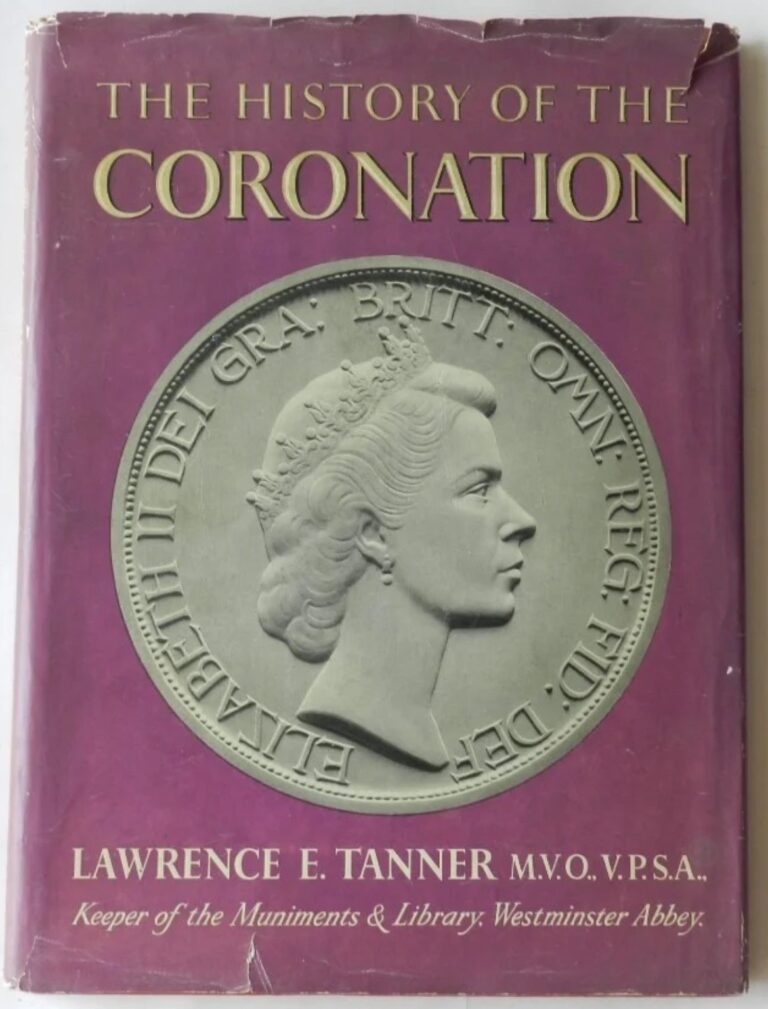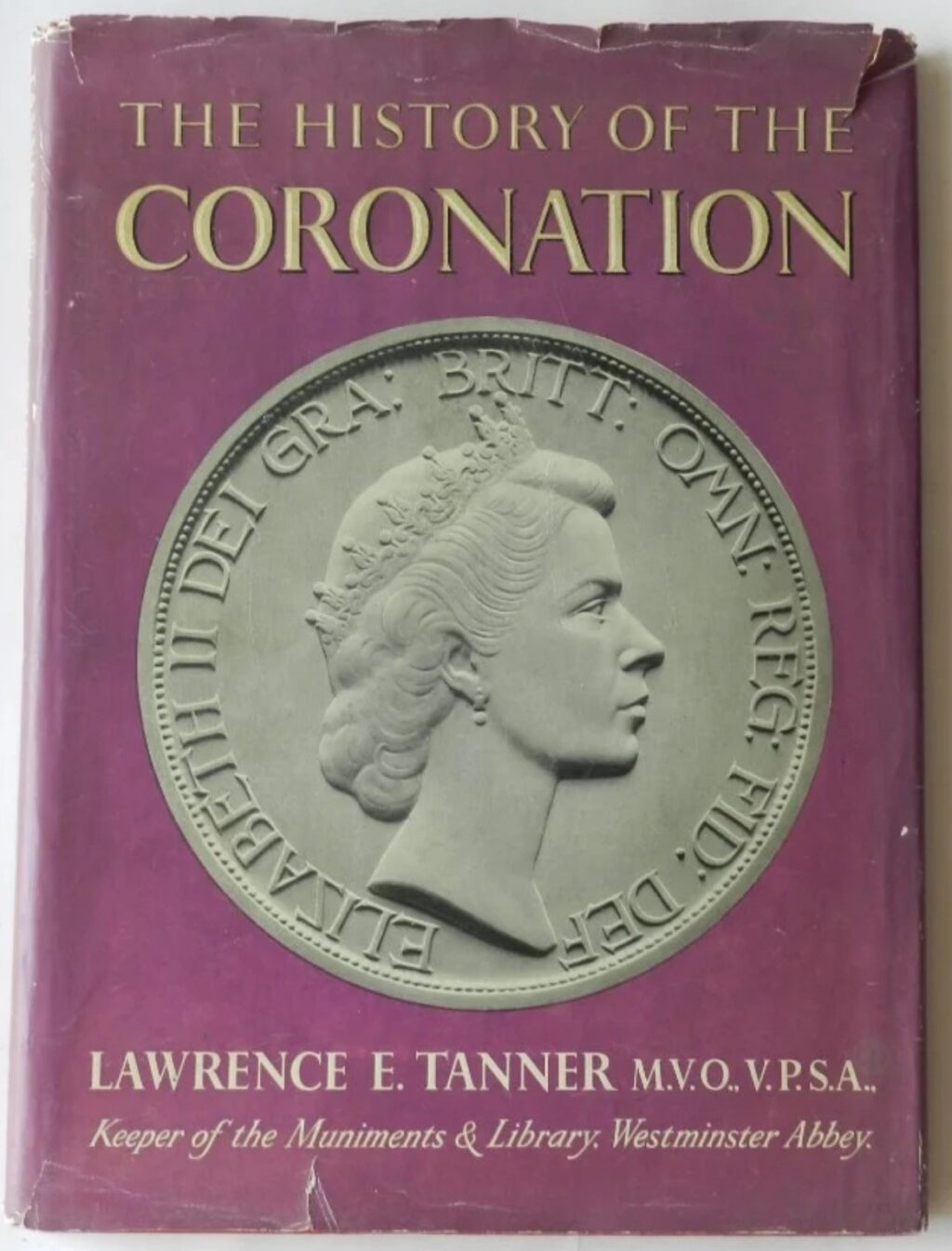Lawrence E. Tanner, The History of the Coronation (1952)
Lawrence Edward Tanner was a Westminster Abbey historian and antiquarian, who has the ‘unique distinction’ of having been baptised, confirmed, married and buried in the Abbey.
Born in Vincent Square in 1890 as the son of the Housemaster at Westminster School, Tanner’s mother died prematurely and he was consequently enrolled as the school’s youngest ever pupil. While a student in 1902 he attended his first coronation (that of Edward the VII), and he would go on to have the distinction of being in attendance for those held in 1911 (George V), 1937 (George VI), and 1953 (Elizabeth II). Indeed, Charles III’s coronation will be the first one since the 19th century which will not feature Tanner (unless one counts the presence of his ashes buried in the vault of the lower Islip chapel in the Abbey).
After serving on the home front during the Great War due to a low medical rating, Tanner would have a career made up of a number of postings at Westminster, including Keeper of the Abbey Muniments (1926-1966), secretary of the Royal Almonry (which arranges the Royal Maundy services) (1921-1964), Vice President of the Society of Antiquaries, Sub-Librarian and later Librarian of Westminster Abbey (1933-1972). Meanwhile, at the 1937 and 1953 coronations he would serve as a Gold Staff Officer.
Published in the lead up to the latter, The History of the Coronation features one hundred and eleven illustrations depicting Westminster Abbey and the 37 monarchs who, at the time of publication, had been crowned there since the Norman Conquest (or as the book is quick to point out 38 if you count Prince Henry, who was crowned while his father Henry II was still alive but ultimately failed to outlive him). The story covered in the book goes back even further, starting with the first Christian consecration of an Anglo-Saxon King, which took place in 785 when Offa, the leader of the Kingdom of Mercia, had his son Egfrith anointed and crowned as his successor.
While Anglo-Saxon coronations had taken place at various places like Kingston-on-Thames (literally King’s-Stone, the boulder on which the King sat for the ceremony), Westminster had become the time-honoured location thanks to its association with Edward the Confessor, whom William the Conqueror claimed to be the legitimate successor to. It was Henry III who in the 13th century had built the modern Abbey – again because he wanted to be connected to the revered Confessor who was seen as the epitome of a devout and religious ruler. The coronation service meanwhile could be traced back to that used by Archbishop Dunstan to crown King Edgar at Bath in 973.
Robert Menzies was famously a monarchist (like the vast majority of Australians in his heyday), and one can imagine him eagerly pouring over his copy of The History of the Coronation in anticipation before attending Elizabeth II’s crowning in 1953. Menzies was fascinated by the history of the monarchy and in a Burkean manner considered its antiquity to be one of its greatest strengths – its endurance and apolitical nature provided secure ballast that minimised the disturbances caused by the partisan fights of Australian democratic life. Nevertheless, he readily admitted that he had some admiration for Oliver Cromwell, and therefore would likely not have been a royalist until the absolute power of the monarch had been checked, and the modern form of ‘constitutional monarchy’, which he so admired, had emerged. As Menzies explained in a speech he gave to mark the 1937 coronation of George VI:
‘900 years ago the King’s authority depended on power. Allegiance to him depended on subjection, because he was an absolute King. To-day the King was a constitutional King, and constitutional monarchy in the British Empire owed its establishment in its present form above all things to the constitutional conduct of the late King George V. It was during the 25 years of his reign that the Crown was established as a constitutional Crown. The position of the King to-day depended not upon power, but in reality upon the absence of power, and upon that subtle element which had nothing to do with power, yet which was all powerful—the respect of the people. Allegiance to the monarch to-day was a free offering of heart, mind, and service to a man who had no power to command it.’
86 years later, allegiance to the Crown is a freer and more discretionary offering than ever. But it is still one that a majority of Australians gave strong endorsement to at the 1999 referendum on the matter.
You might also like...
Sign up to our newsletter
Sign up for our monthly newsletter to hear the latest news and receive information about upcoming events.



